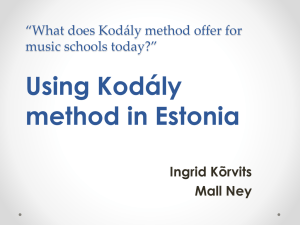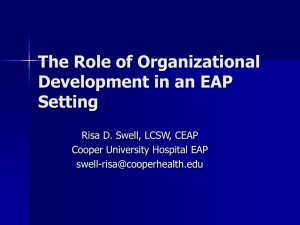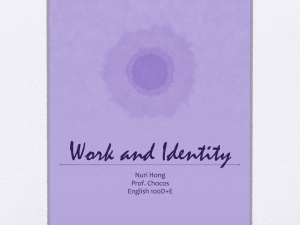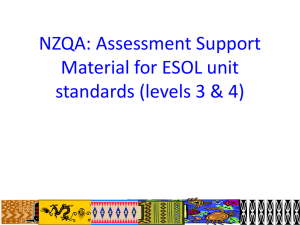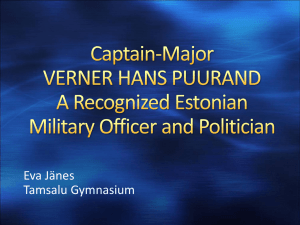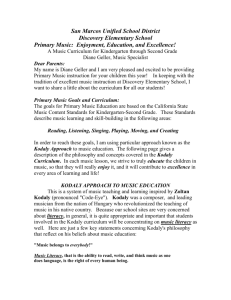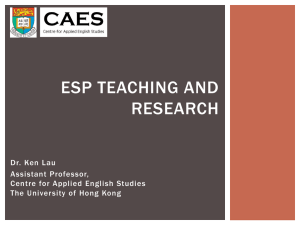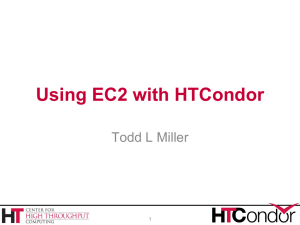the presentation
advertisement
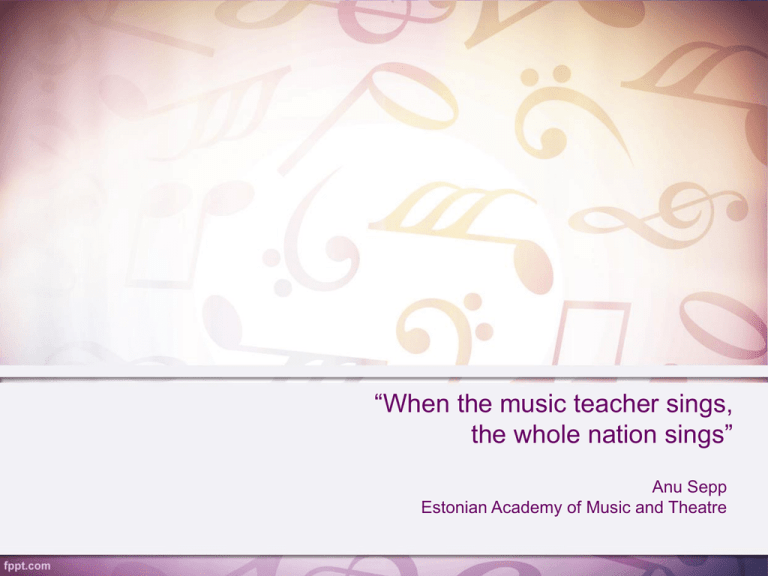
“When the music teacher sings, the whole nation sings” Anu Sepp Estonian Academy of Music and Theatre Estonians – a singing nation • Kui laulab kool, siis laulab rahvas. Zoltan Kodaly 2 TRADITION CONTINUITY 3 Joint singing in Estonian musical heritage • Runic songs – carry an important message to participants and audiences and forms their feeling of unity • Congregational singing - Singing in village and parish schools (at Laiuse parish school in 1822, singing lessons were held every day) – The first Estonian music books for schools – 1864 by A. Erlemann and in 1868 by F. Kuhlbars • Choir singing Cimze seminar • 1849 - 1881 in Valga to train teachers and parish clerks of Livonia • about 120 Estonians studied there • very good music education (harmony, improvisation, composition, choir singing, folk songs (arrangements) • the choir movement in Estonia that lead to the first Song Festival in Tartu in 1869 Janis Cimze Innovative educational ideas at the beginning of the 20th century • Pupil centredness • Nationality • Integration between different subjects Johannes Käis • Creativity RIHO PÄTS (1899-1977) – Relative music reading system (based on tonika-do method - Vilho Siukonen) – Shifting quater note – Playing instruments (recorder, percussion instruments,mandolin) – Joint singing Anu Sepp 2010 7 1960s in Estonian music education Prof. Heino Kaljuste in collaboration with prof.Riho Päts • JO-LE-MI method • Orff-instrumentarium • Music specialized classes • Kabalevski’s method of music listening • New music syllabi and music books (1925 – 1989) Anu Sepp 2010 8 Estonian general music education • The whole concept of Estonian music education - by the end of the 1930s by Riho Päts • Music education – from kindergarten to the end of upper secondary school (gymnasium) • Since 1962 – special Song festivals for children and youth – 1st, 28.06–1.07.1962, Tallinn, 17 760 participants – 11th, 1.–3.07.2011, Tallinn, 32 500 participants • The holistic system of music education (ideas of Orff, Kodaly, Päts + new pedagogies) Music education in Estonian general education • Estonian National Core Curriculum (valid from January 28, 2010) • Distribution of music lesson hours in general education (per week) – Basic school • stage I grades 1−3 2+2+2 lessons • stage II grades 4−6 2+1+1 lessons • stage III grades 7−9 1+1+1 lessons – Upper secondary school • 3 courses 3 x 35 lessons Estonian music syllabus • singing • playing musical instruments • musical movement • composing • listening to music and musicology • musical literacy • educational outings (National Curriculum,2011). Choir singing • A voluntary subject • About 555 choirs - 226 toddlers’, 168 childrens’, 55 boys’, 64 mixed, 11 male and 28 female choirs (according to 2011 Youth song festival) • TIMETABLE – as a subject but not in all schools • So far, usually not added to music teacher’s hourly working load MUSIC TEACHER – THE KEY PERSON Music teachers’ qualification • music is taught usually by music subject teacher (from kindergarten to upper secondary school) • music teacher - choir conductor (up to 1990s) • 2002 curriculum reform in university education – “….is allowed to work in positions requiring the …. degree or appropriate qualification” • 2013 new teacher education requirements – “…has received training in working as music teacher in basic and upper secondary school” Music teacher training in Estonian Academy of Music and Theatre Bachelor’s degree – usually 3 years, 180 EAP A Professional subjects 30 EAP – Music didactics ( Orff pedagogy, Kodaly method, pre-school music) – Educational science and psychology B Practical music subjects 100 EAP – Choir – Conducting and vocal training – Music instruments (piano, recorder, 6-string zither, guitar) and solfege – Rythmic music (pop, jazz, rock) – Choir music (optional) – Electronic music(optional) C Music theory, history and general studies 35 EAP – Music history – Music theory and analysis – Other humanitarian subjects and general studies D Bacholor examination 10 EAP E Elective subjects 5 EAP Music teacher training in Estonian Academy of Music and Theatre Master’s degree – usually 2 years, 120 EAP emphasis on teacher training: Master’s studies 100 EAP - vocational studies (general studies 24 EAP; didactics 12EAP; practice 24 EAP) - 60 EAP - professional studies 24 EAP - general studies 10 EAP - elective subjects 6 EAP Master’s thesis 20 EAP Model of pedagogical thinking level (Kansanen, 1991, 1993) Model of pedagogical thinking in music education context THINKING LEVEL ESSENCE OF MUSIC TEACHERS’ THINKING METATHEORY LEVEL - vision of music education’s task in the society and pupils’ everyday life - the ability to consider critically the traditions of music (subject) didactics and reflect one’s own teaching through this critical analysis - awareness of the history of music education, traditions, values - understanding about the philosophical underpinnings of music education OBJECT THEORY LEVEL ACTION LEVEL - perception of/about the music education syllabus as part of the school curriculum - awareness of the theoretical criteria of the music subject: objectives, main concepts, formation of the content and structure in teaching –learning process - ability to reflect on music teaching techniques, methods, approaches in one’s own practice - basic knowledge of music subject content and skills - perception of different techniques, methods and models that are most suitable for music teaching - ideas of the musical skills of the students and about the main problems connected with content learning - a vision of the main differences between different groups and its impact on the whole music teaching process - contextual solutions in music subject connected to content prioritization in the music syllabus of national curriculum - ability to create suitable music material and find appropriate repertoire Use of music teaching ideas and methods Use of music practices Correlations between music practices and methods (Estonia) *. Correlation is significant at the 0.05 level (2tailed). **. Correlation is significant at the 0.01 level (2tailed). ***. Correlation is significant at the 0.001 level (2tailed). Estonia D2.21 Singing D2.21 D2.22 Playing Singing instruments D2.25 D2.24 Listening to Integrative pieces of creative tasks music D2.23 Musical movement D2.26 Studying the history of music D2.27 Learning elementary theory D2.29 D2.210 Involved in Improvise, arts compose their D2.7A teamwork own music Carl Orff D2.28 Concerts, excursions 1 0,060 0,013 -0,050 0,177 0,122 0,118 -0,153 0,128 D2.22 Playing instruments 0,060 1 ,514(**) ,277(**) -0,058 -,270(**) 0,115 0,092 0,178 D2.23 Musical movement 0,013 ,514(**) 1 ,320(**) -0,003 -,303(**) 0,137 0,117 ,205(*) ,442(**) -0,050 ,277(**) ,320(**) 1 0,123 0,065 -0,018 ,297(**) ,316(**) D2.25 Listening to pieces of music 0,177 -0,058 -0,003 0,123 1 ,431(**) ,238(*) 0,127 D2.26 Studying the history of music 0,122 -,270(**) -,303(**) 0,065 ,431(**) 1 ,200(*) D2.27 Learning elementary theory 0,118 0,115 0,137 -0,018 ,238(*) ,200(*) D2.28Concerts, excursions -0,153 0,092 0,117 ,297(**) 0,127 D2.29 Involved in arts teamwork 0,128 0,178 ,205(*) ,316(**) D2.210 Improvise, compose their own music 0,082 ,447(**) ,442(**) D2.7A Carl Orff -0,076 ,276(**) D2.7B Zoltan Kodaly -0,022 D2.7C Emile Jaques-Dalcroze D2.7F David Elliot -0,076 -0,022 0,074 0,018 0,032 0,062 ,447(**) ,276(**) 0,064 0,132 0,114 0,117 -0,064 0,149 -0,077 0,168 -0,060 ,195(*) -0,013 ,220(*) 0,130 0,056 ,245(*) ,199(*) -0,025 0,182 -0,012 -0,077 -0,086 0,032 0,088 0,025 -0,029 0,020 ,257(**) ,190(*) -0,115 -0,007 0,062 -0,006 0,045 -0,057 0,051 1 0,072 ,203(*) ,237(*) 0,031 0,056 -0,028 -0,106 0,006 -0,066 ,257(**) 0,072 1 ,257(**) 0,184 0,064 0,042 0,114 ,191(*) -0,102 ,191(*) -0,012 ,190(*) ,203(*) ,257(**) 1 ,327(**) 0,120 0,041 ,228(*) ,281(**) 0,057 ,263(**) ,220(*) -0,077 -0,115 ,237(*) 0,184 ,327(**) 1 ,373(**) 0,171 ,193(*) 0,095 0,133 0,149 0,130 -0,086 -0,007 0,031 0,064 0,120 1 ,574(**) ,280(**) ,287(**) ,301(**) 0,163 0,064 -0,077 0,056 0,032 0,062 0,056 0,042 0,041 0,171 ,574(**) 1 0,074 0,132 0,168 ,245(*) 0,088 -0,006 -0,028 0,114 ,228(*) ,193(*) ,280(**) 0,170 D2.7D Shinichi Suzuki 0,018 0,114 -0,060 ,199(*) 0,025 0,045 -0,106 ,191(*) ,281(**) 0,175 ,287(**) D2.7E Riho Päts 0,032 0,117 ,195(*) -0,025 -0,029 -0,057 0,006 -0,102 0,057 D2.7F David Elliot 0,062 -0,064 -0,013 0,182 0,020 0,051 -0,066 ,191(*) ,263(**) D2.24 Integrative creative tasks 0,082 D2.7C Emile D2.7D Jaques- Shinichi D2.7E Dalcroze Suzuki Riho Päts D2.7B Zoltan Kodaly ,373(**) 0,084 ,290(**) ,281(**) 1 ,559(**) 0,084 ,559(**) 0,095 ,301(**) ,290(**) 0,133 0,170 0,175 0,116 1 0,116 ,660(**) -0,071 ,508(**) -0,071 1 0,035 0,163 ,281(**) ,660(**) ,508(**) 0,035 1 Correlation of musical practices, their internal connections and factor patterns in Estonia r = .363** FACTOR 1 FACTOR 2 D229 arts teamwork r =.205* D223 musical movement r =.514*** r =.327*** D222 playing instruments pc =.337 pc =.696 pc =.709 r =.316*** r =.203* r =.277* r =.257** r =.320*** r =.-303** r =.442*** r =.447*** D224 integr. creative tasks r =.220* D2210 improvising, composing r =.-270** pc =.565 D228 visiting concerts, museums etc r =.297** pc =.681 pc = .651 r =.190* D226 history of music r =.237* D227 learning elementary theory pc =.542 r =.200* pc =.452 r =.257** r =.431*** r = -.038 n.s. r =.238* FACTOR 3 D225 listening to music pc =.477 D221 singing r = .184 pc =.520 n.s. Estonian Society for Music Education • founded in 1990 • About 286 members • Support music teachers in their everyday work; • Mediation of the newest information in music education; • Develop international communication; • Offer possibilities for inservice training. Curriculum Development: Theory and Practice Hilda Taba, 1962 ...schools function on behalf of the culture in which they exist. The school is created by a society for the purpose of reproducing in the learner the knowledge, attitudes, values, and techniques that have cultural relevancy or currency.[---] ...of the many educative agencies of society, the school is the one which specializes in inducting youth into the culture and is thus responsible for the continuity of that culture. (Taba, 1962,11) ...Koolid toimivad selle kultuuri huvides, milles nad eksisteerivad. Koolid on loodud ühiskonna poolt eesmärgiga kanda õppijas edasi neid teadmisi, suhtumisi, väärtusi ja oskusi, millel on kultuuriline tähtsus või väärtus. [---] ...just kool on see paljudest ühiskonna haridusasutustest, mille ülesanne on juhtida noor kultuuri juurde ning seega kanda vastutust selle kultuuri säilimise eest. 17 Music as part of identity • If I forget the song and the language, will I remember myself? Jaan Kaplinski Thank you for your kind attention!
